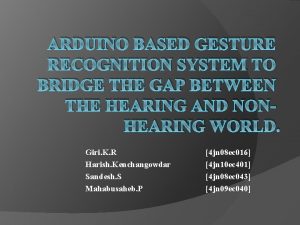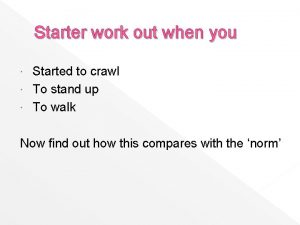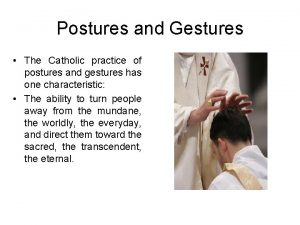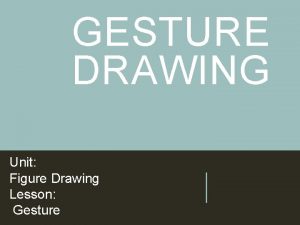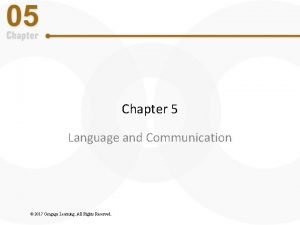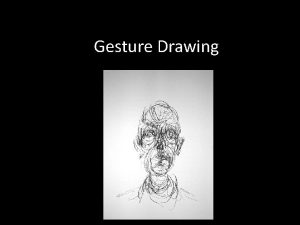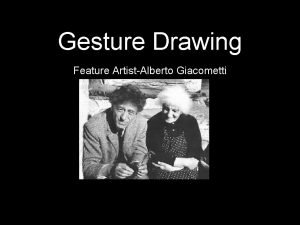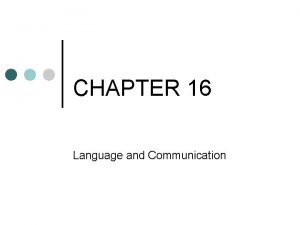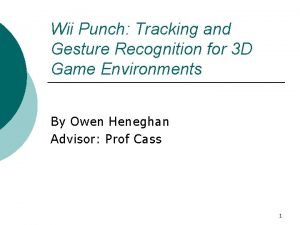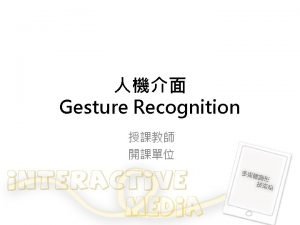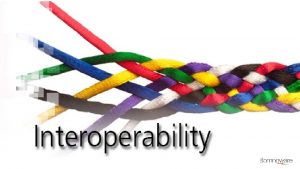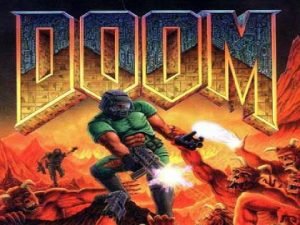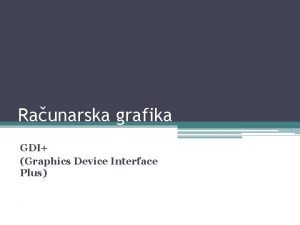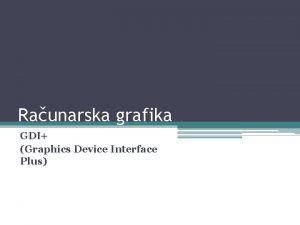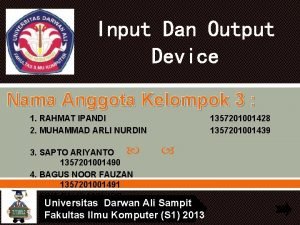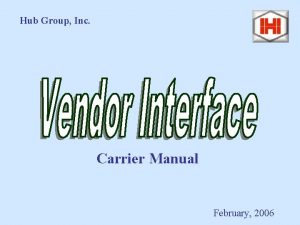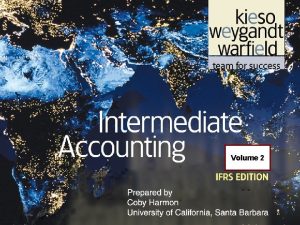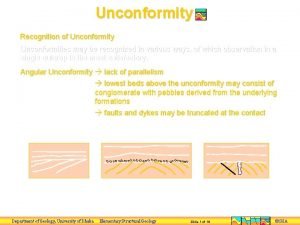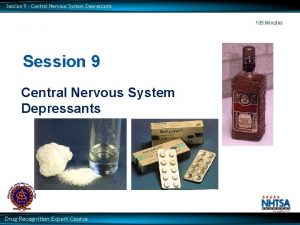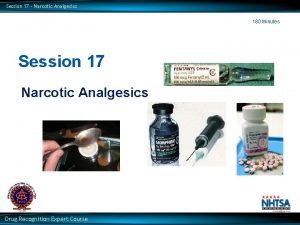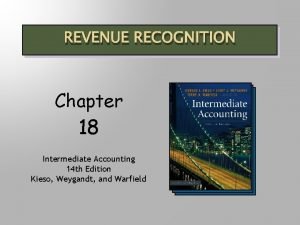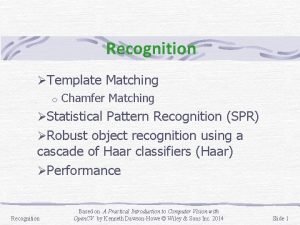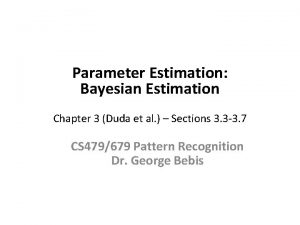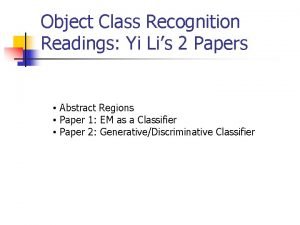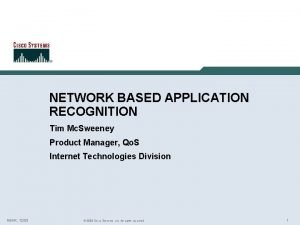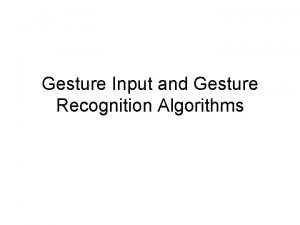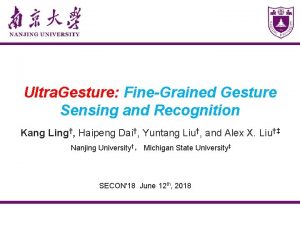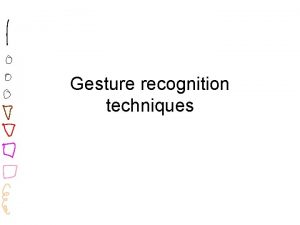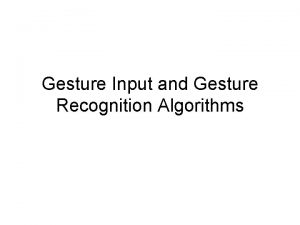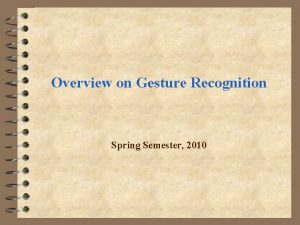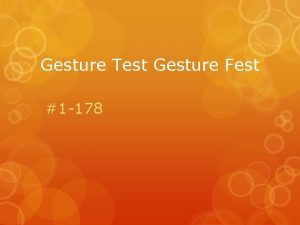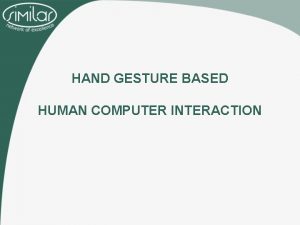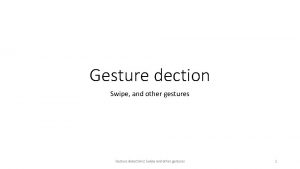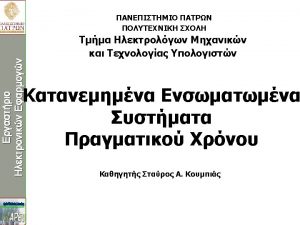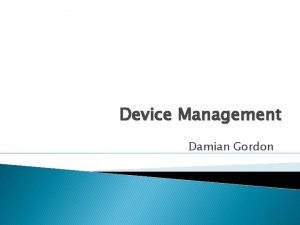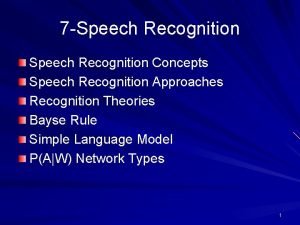Gesture Recognition Interface Device Group 22 Group 22









































- Slides: 41

Gesture Recognition Interface Device Group 22

Group 22 Members: • • Martin Rodriguez- EE Landon Splitter- CE Evianis Cruz- EE Pamela Garcia- EE

Project Introduction

Motivation and Goals • Motivation- To provide the user with a natural and less restrictive way to communicate with the computer. • Goal – To design an intuitive device with high responsiveness to make the experience continuous, as opposed to fragmented.

Project Requirements and Specifications • • • Operating Range: up to 20 ft. Weight < 250 g Battery Life > 10 hrs FPGA: Real Time Image Processing (30 fps) Response Time/Gesture Recognition < 2 sec Low Cost < $400. 00

Design Overview SS 2 SS 4 SS 3 SS 1

SS 1: Camera SS 2 SS 4 SS 3 SS 1

SS 1: Camera • • Module size: 32 mm x 32 mm Image sensor: CMOS 1/4 inch Output format: Standard JPEG/M-JPEG Frame speed: 30 fps Resolution: 640*480 Monitoring distance: Up to 15 m Operating voltage: 5 V Communication: TTL

Near-IR LED Multicomp

SS 1: Visible Light Filter • Goal: Block background noise (visible light) and allow the near-IR wavelengths to reach the camera sensor. • Approach: Install visible light (magnetic disk of a floppy disk or film).

SS 2: FPGA SS 2 SS 4 SS 3 SS 1

SS 2: FPGA vs. DSP Processor Characteristic FPGA Performance X Parallelism X Power Consumption X Reliability and ease of maintenance X Low Cost X Development Software DSP X

SS 2: Image Acquisition via FPGA Basys 2 - Xilinx Spartan 3 E • 100, 000 Logic Gates • Full-speed USB 2 • Flash ROM to store FPGA configurations • User-settable clock (25/50/100 MHz) • Socket for a 2 nd clock • Four expansion connectors • ESD and short circuit expansion on all I/O signals

SS 2: Image Acquisition FPGA Pre-processing • Stream video from camera through FPGA • Calculate location of LED 1 (cursor location) • If a second LED comes on calculate centroid between the two points. • Does the movement correspond to a gesture? • FPGA outputs frame coordinates to host computer

SS 2: Image Processing Output of FPGA RGB Image Gray Scale Conversion Median Filter Thresholding Development Software: Simulink & HDL Coder Object Identification Geometry Calculations Output

Image Acquisition System Success • Stream Video • Test FPGA functionality • Test a Simulink model with some filtering Difficulties Interfacing the camera with FPGA • HDL coder from a Simulink model • FPGA Logic Gates • Clock Speed •

SS 3: Host Computer SS 2 SS 4 SS 3 SS 1

SS 3: Host Computer • Requirements: • Current consumer grade PC with Windows OS • Free USB/Serial ports • Goals: • Plug N Play style system • All heavy computing not on PCs CPU

SS 3: Driver • Coding in C++ • Takes input from two I/Os • Handles movement and gestures

Class Diagram Mouse Driver

Host Computer Success • Integrate driver with USB ports • Read in and modify information from I/O ports Difficulties Listening to two ports simultaneously • Integrating gestures that will flag different commands •

Design Overview SS 2 SS 4 SS 3 SS 1

SS 4: Gloves Master Hand • Bluetooth Module • Gyroscope and Accelerometer: MPU-6050 by Inven. Sense • Microcontroller: Stellaris LM 4 F 120 • Near-IR LED (940 nm & 30˚ viewing angle) • Touch sensor • Battery and Voltage regulating circuit

SS 4: Gloves Secondary Hand • Near-IR LED (940 nm & 30˚ viewing angle) • Touch sensor • Battery

Development Environment Code Composer Studio Arduino IDE • C/C++ and Assembly • More Debugging options. • Direct access to control registers • Flexible clock system, Low power options, interrupt friendly • Limited support • Free (Code limited) • Arduino wiring language • Simple and easy to use, but limited Debugging options • Fixed Clock speed and no power options • Wealth of user support and existing code libraries • Free

Development Environment Code Composer Studio Arduino IDE • C/C++ and Assembly • More Debugging options. • Direct access to control registers • Flexible clock system, Low power options, interrupt friendly • Limited support • Free (Code limited) • Arduino wiring language • Simple and easy to use, but limited Debugging options • Fixed Clock speed and no power options • Wealth of user support and existing code libraries • Free

MCU MSP 430 g 2553 Stellaris LM 4 F 120 Arduino UNO • 3. 3 V • 16 MHz • UART, I 2 C, SPI • 4. 30$ • DIP • 3. 3 V • 80 MHz • UART, I 2 C, SPI • 12. 99$ • LQFP • 5 v • 16 MHZ • UART, I 2 C, SPI • 29. 95$ • DIP

MCU MSP 430 g 2553 Stellaris LM 4 F 120 Arduino UNO • 3. 3 V • 16 MHz • UART, I 2 C, SPI • 4. 30$ • DIP • 3. 3 V • 80 MHz • UART, I 2 C, SPI • 12. 99$ • LQFP • 5 v • 16 MHZ • UART, I 2 C, SPI • 29. 95$ • DIP

Bluetooth TTL transceiver module • • • Bluetooth V 2. 0 3. 3 V input voltage 8 m. A once connected UART w/ Baud rate up to 115200 Low cost. 10$ 2 wires RXD, TXD.


MPU-6050 • • • Tri-Axis gyroscope and accelerometer 3. 3 V input voltage 3. 8 m. A (Gyro + Accel No DMP) Programmable interrupts Fast I 2 C communications (400 k. Hz)


Dynamic Time Warping • Compare two time-signals with variable speeds. • Algorithm is of O(n 2) • Modifications to better perform in MCU RISC structures. Note: During algorithm execution the Stellaris’ Master clock is ramped up to 80 MHz.

Gloves Success • Dynamic time warping algorithm ported to C language • Interface with Bluetooth module • Configuring MPU’s basic functions Difficulties • Inconsistent results with I 2 C. • Testing the efficiency of DTW algorithm on Gyro data • Optimize code for low power

Stellaris Power Requirements Power Reqs for Stellaris LM 4 F • 3. 3 v Vcc • Run mode 1 (Flash loop): nominal 50 m. A w/ all peropherals ON and System clock = 80 MHz • Sleep mode: 4. 5 m. A • Power source: ▫ 3. 7 v Lithium-ion battery. • Buck (step-down)-Boost(stepup) Converter

Li-ion Battery characteristics • Variable voltage throughout battery discharge cycle • Can drop below regulated voltage

Voltage regulation • LTC 3531 - 200 m. A Buck-Boost Synchronous DC/DC Converters Features: ▫ Regulated Output with Input Above, Below or Equal to the Output ▫ Single Inductor ▫ Up to 90% Efficiency ▫ VIN Range: 1. 8 V to 5. 5 V


Budget and Financing Date Name Part Price Sep 3 Pamela G. /Martin R. MPU 6050 x 2 $21. 00 Sep 3 Evianis Cruz Bluetooth Module r 2232 $11. 96 Nov 18 Pamela Garcia Basys 2 $58. 89 Oct 5 Martin R. /Landon S. Stellaris Launchpadx 2 $4. 78 Jan 20 Martin Rodriguez MPU 6050 $12. 86 Nov 18 Pamela Garcia Near-IR LEDs $9. 92 Jan 20 Evianis Crus. Li-Ion Battery $13. 95 Jan 21 Martin Rodriguez LTC 1147 -3. 3 $5. 25 Jan 21 Martin Rodriguez EEPROMs 7. 98 Other $50. 00 Total: $196. 59 Total Spent so Far: $196. 59 Expected Budget: $400. 00 Self-Funded: $100 per member

Project Progress MPU 6050 Dynamic Time Wrapping Bluetooth Power Circuitry Driver Asthetics of Gloves FPGA Camera 0 10 20 30 40 50 60 70 Percent Change (%) 80 90 100

Questions?
 Hand gesture recognition project using arduino
Hand gesture recognition project using arduino Internal input devices
Internal input devices How to draw input devices
How to draw input devices Interface in java
Interface in java Fluidity in hci
Fluidity in hci Office interface vs industrial interface
Office interface vs industrial interface Interface------------ an interface *
Interface------------ an interface * Catholic hand gesture
Catholic hand gesture When do kids say their first word
When do kids say their first word Oran posture
Oran posture Gesture drawing examples
Gesture drawing examples Gesture exercises
Gesture exercises Gesture brisk erect walk shows
Gesture brisk erect walk shows Gesture-call system
Gesture-call system Gesture drawing definition
Gesture drawing definition Albert giacometti
Albert giacometti An ancient gesture
An ancient gesture Gesture-call system
Gesture-call system Hand gesture punch game
Hand gesture punch game Gesture definition
Gesture definition Head nodding
Head nodding Somnoware device interface
Somnoware device interface Mobile robot navigation with human interface device
Mobile robot navigation with human interface device Gdi graphics device interface
Gdi graphics device interface Grafika bmp
Grafika bmp A tagout device is preferable to using a lockout device.
A tagout device is preferable to using a lockout device. Kelompok output
Kelompok output Hub group vendor interface
Hub group vendor interface Proposal for employee recognition program
Proposal for employee recognition program Chapter 18 revenue recognition
Chapter 18 revenue recognition Four part processing model for word recognition
Four part processing model for word recognition Recognition of unconformity
Recognition of unconformity Loss recognition testing
Loss recognition testing Drug recognition expert chart
Drug recognition expert chart Drug recognition expert chart
Drug recognition expert chart Chapter 18 revenue recognition solutions
Chapter 18 revenue recognition solutions Template matching pattern recognition
Template matching pattern recognition Deped order no. 36 s. 2016
Deped order no. 36 s. 2016 Problem recognition adalah
Problem recognition adalah Bayesian estimation
Bayesian estimation Object class recognition
Object class recognition Cisco nbar
Cisco nbar
